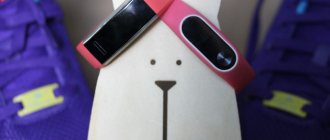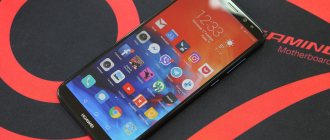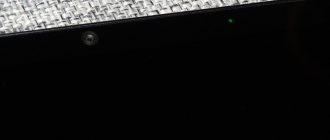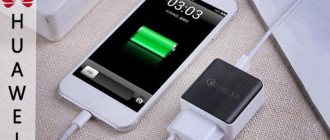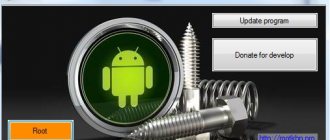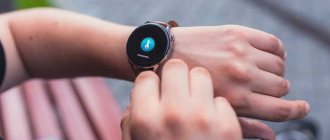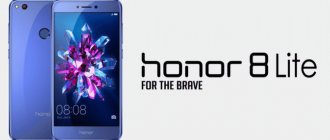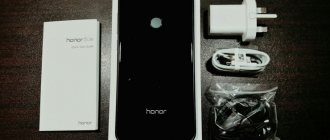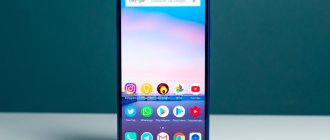Characteristics
To make a full comparison of Huawei P20 vs Huawei P20 Lite, you should first consider the characteristics of the devices. Quite often it happens that modifications differ in memory capacity or display size. In this case, the difference will not be only this. Devices differ in processors and some other parameters. Full specifications are shown in the table.
Huawei P20 smartphone
| Characteristics | Huawei P20 | Huawei P20 Lite |
| OS | Android 8.1 | Android 8.0 |
| Display | 5.8 inches, 2240*1080, IPS, Gorilla Glass 5 | 5.84 inches, 2280*1080, IPS, Gorilla Glass 5 |
| CPU | Kirin 970 | Kirin 659 |
| Memory | 4/128 GB | 4/64 GB |
| Main camera | 12+20 MP, laser focus tracking, 2x optical zoom | 16+2 MP |
| Front-camera | 24 MP | 16 MP |
| battery | 3400 mAh, fast charging | 3000 mAh |
| Interfaces | Wi-Fi, Bluetooth, Type-C, NFC, GPS, Glonass, LTE | Wi-Fi, Bluetooth, Type-C, NFC, GPS, Glonass, LTE |
| Protection | IP - 53 | |
| Size and weight | 149.1*70.8*7.65 mm, 165 grams | 148*71*7.4 mm, 145 grams |
Huawei P20 Lite smartphone
If you look at the characteristics listed above, you will notice that the Huawei P20 differs from the P20 Lite in its hardware rather than its design or dimensions . The older model, with a slightly smaller screen size, turned out to be heavier, longer and thicker. In addition, the device is protected from water and dust; the younger version did not receive it.
Huawei P20
From what is not indicated in the table, the following should be noted.
- P20 has stereo speakers, faster memory.
- The younger device benefits from the fact that memory can be added to it. The older gadget has a main memory limited to 128 gigabytes. However, this volume is enough for most tasks.
- Another difference is that the older version comes with a case and a headset, while the Lite only received a headset.
Conclusion. In terms of security, sound, and equipment, the P20 earns one point and opens the score 1:0 in favor of the older model.
Appearance
If you compare the Huawei P20 and P20 Light in appearance, the devices are practically no different. Both devices are not slippery, and the phones are the same in terms of the number of colors. In order not to describe the models completely, because there are a lot of reviews on the Internet, for comparison it makes sense to indicate only the differences - they are minimal.
- The older model has a fingerprint scanner located under the screen. Due to this, the diagonal is slightly smaller than that of the P20 Lite. The latter has a scanner located on the back; it is a traditionally round module.
- The next difference is that the older device has a laser focus. It is located under the camera and just above the flash. The Lite version does not have autofocus.
- The P20 has a glass back panel that resembles a mirror; the P20 Lite has a back panel made of several layers that shimmer beautifully in the sun.
- Another point that can make it clear which device is cheaper is the side edges. The edges of both devices are sloping, but the P20 has a distinctly metallic feel to it. The P20 Lite also has a metal frame, but it's made to feel like plastic.
- The younger device has a lower quality oleophobic layer. The model quickly becomes covered with fingerprints, both front and back.
The arrangement of elements, control buttons - everything is completely identical. If you look at the phones and don’t pick them up, it seems that they are almost twins. But when the devices fall into the palm of your hand, the difference becomes noticeable. This was done so that, after looking at the models, the buyer became interested in both devices, but when he took them in his hand, he felt the difference and bought a more expensive version.
Conclusion. The models do not differ in design, and no participant in the competition receives a point. But in terms of tactile sensations, the P20 is a cut above and due to this, it takes the lead with a score of 2:0.
Huawei P20 Lite
This is a truly “people's” flagship, which from the very start of sales did not have a high price tag, but at the same time it collected all the newfangled “tricks”. We are talking about all modern methods of personal identification on a smartphone, widescreen display, dual camera module, which should be given a lot of attention.
No less significant is the design of the device, which has already become a “brand name” - a glass case in a colored design that shimmers in the sun. This looks especially impressive in combination with the “unlimited screen” on the front panel. Without exaggeration, the gadget looks premium and at the same time very youthful.
This year’s “junior” flagship has a proprietary processor as its hardware basis, which ensures consistently fast operation of the smartphone. In addition, the phone is capable of handling almost any demanding application or heavy task. For example, video editing for the P20 Lite is okay.
A few words about the display: the front panel of the device is “decorated” with a 5.84-inch diagonal screen with Full HD+ resolution. This miracle occupies almost the entire front panel of the smartphone. On top there is a panel for sensors, which is very similar to the iPhone X. The lower part of the front panel is occupied by the inscription “Huawei”. By the way, the fingerprint scanner is located on the back of the gadget.
The device has cameras capable of creating fairly high quality images. In addition, P20 Lite is endowed with other chips and features. All of them arouse consumer interest, which is why the device is in great demand.
Display
Both models received the same IPS matrices. Due to the slightly larger display, the P20 Lite has a slightly higher resolution. Overall, both matrices are good. There is a high margin of brightness, color saturation, and viewing angles. The downside is that both models convey gray color unnaturally, and the color display calibration itself is not very accurate . Visually this is not noticeable, you can only see that the gray color is not very gray. The screen settings are the same, there is eye protection, automatic brightness adjustment, and color temperature adjustment.
Conclusion. The models are equivalent in terms of screens, but if you take into account the price of the older device, the matrix could be configured better. For this reason, one point goes into the P20 Lite treasury, and thus the score becomes 2:1. The leader is still the older device.
Results
Both smartphones have a modern design and good ergonomics. They have sufficient power reserves and memory. At the same time, the popular headphone jack and a combined slot for installing a memory card remain. What has changed in the new model compared to the previous one?
Advantages of Huawei P30 Light:
- Larger display diagonal
- Modern processor
- Higher RAM capacity
- There is a third (widescreen) sensor that expands the camera's capabilities
- Higher battery capacity and autonomy
In a comparison between Huawei P30 Lite and P20 Lite, the first model wins.
Battery
Both models have a non-removable battery, but the older model has a larger 400 mAh battery. If we translate this into hours of use, then the P20 can withstand about 1.5 days of load, the P20 Lite will last 18-20 hours. From the point of view of watching videos and games, the results are the same - 5 hours of toys, 7-8 hours of movies. The P20, with a slightly larger battery, has a serious advantage in autonomy, and this was achieved thanks to a processor that is more intelligent than its younger brother.
On a note! Huawei P20 Pro, the oldest brother in the family, can work without charging for about two days, which is very worthy for a modern flagship.
The P20 has SuperCharge charging technology, a junior QuickCharge device . The difference lies in the battery charging time. The older model will reach 65% in 30 minutes, and 100% charge in 70 minutes. The younger device will receive 50% of the battery in 30 minutes, and can get the full amount in 100 minutes. The difference is significant.
Conclusion. After assessing autonomy, the point goes to P20, and the score becomes 3:1
Differences between P20 and P20 Pro
The previous line of Huawei P10 smartphones has been supplemented by the P10 Plus model with a larger screen. The current P20 line boasts the Huawei P20 Plus model, which has not just a 6.1-inch screen, but also expanded functionality (compared to the standard version). The main addition is related to the cameras: due to the third 8 MPx module, 3x magnification is possible without loss of quality (for comparison, in the iPhone X and Galaxy S9, it is only 2x). The main camera module has a colossal resolution of 40 MPx (an absolute record among all smartphones from this company).
Due to triple modularity, it was possible to achieve light sensitivity that is incredible for smartphones: ISO is 102,400, which is comparable to good semi-professional cameras. Instant focusing and super slow-motion video, combined with the above capabilities, put this model on par with the flagships of Samsa and Apple.
Camera
Perhaps the most interesting point of comparison concerns the cameras. The fact is that older models were positioned primarily as camera phones. This is noticeable in the characteristics. The older device with the Pro prefix received three matrices on the back, the P20 had two, the P20 Lite also has two, but they are much simpler, there is also no laser focusing, the auxiliary camera does not collect information and serves only to blur the background. There is no optical stabilization in any phone, and if the P20 Lite has this forgivable due to the price tag, then for the P20 it is downright unpleasant.
Camera Huawei P20 Pro
What is the output? The result is very interesting.
- In good lighting conditions, the younger device shoots better in terms of detail preservation. The Pro version makes photos too light (in comparison), while the P20, on the contrary, is dark.
Example photo from Huawei P20 smartphone
Example photo from Huawei P20 Pro smartphone
- When it comes to noise and dynamic range, the P20 Lite falls short here. Shooting at night with both models shows that the presence of laser focusing makes a difference, and the P20 takes better pictures, although it still has a lot of soap.
Example photo from Huawei P20 Light smartphone
In general, the impression from photographs in low light is not the best, but again we remember the price, and it turns out that the younger device looks more advantageous. Due to the price, this can be forgiven, but for an older smartphone, which is far from cheap, this cannot be forgiven, although the reason is clear. There is the oldest device, and it would be strange if the photos in it turned out to be similar to the younger models.
The front cameras in both models take decent pictures, but the P20 still leaves a more pleasant impression. The selfies here are really high quality, and for those who like to take pictures of themselves, this smartphone is more suitable. Video shooting on the P20 Lite is FHD, on the P20 – 4K, the quality is better on the older model.
The camera interface of the older version is overloaded, and in some places you can get confused . This is because the processor is equipped with artificial intelligence (AI) cores. They perform a number of functions, including collecting information about the photo, which over time allows you to more accurately select settings in automatic modes. The first reviews were not very favorable to the AI technology, but as updates were released, the system began to work better. This is especially noticeable in the P20 Pro, which itself has better cameras, and with the help of AI it becomes even more interesting in this matter.
Conclusion. The P20 shoots better at night with the front camera, and is generally less noisy. However, the lack of optical stabilization makes a lot of noise in photos, and the device loses to competitors in its price segment. The P20 Lite has a slightly worse camera, but among rivals within 20 thousand it is difficult to find something similar in camera. It is for this reason that both models receive a point. The P20 is better than the Lite, but worse than the competition. Lite, on the contrary, is inferior to its older brother, but confidently outperforms its colleagues on the market. The score becomes 4:2, the leader is still P20.
Features of smartphones
Smartphones have a number of modern features. It is worth recognizing that there are a little more of them in the P20 Lite - over the year, progress in the world of smartphones has stepped forward a little.
For example, two smartphones have user recognition by face. It’s just that the P20 Lite had it initially, but the P10 came only with firmware updates, as a software add-on. Therefore, this feature has a bit more options on this year's flagship.
There is a fingerprint scanner in both places. In only one solution is it on the front of the smartphone, built into the “Home” button, and in the second – on the back. Each variation has its fans. For example, if you think that the fingerprint scanner on the back cover spoils the appearance of the device, take a closer look at the P10.
Control by gestures and voice – this is also available in two smartphones. True, in P20 Lite these chips have a little more options for use. They are mainly related to the face scanner.
The P10 has a 3200 mAh battery, the Huawei P20 Lite has a 3000 mAh battery. At the same time, both smartphones are charged in an hour, thanks to fast charging. The gadgets use USB-type C.
The differences include: the limitless screen and its “chips” in the P20 Lite, as well as the touch control key under the screen in the P10.
CPU
The P20 has 4 gigabytes of RAM and 128 built-in, there is no option to expand the memory. The reading speed is high – 7600 Mbit/s and 500 Mbit/s. The performance is similar to the Pro version, which is good. The Kirin 970 processor is a powerful chipset with four cores at 2.4 GHz and four at 1.8 GHz, the performance is more than decent. The model copes with all tasks and scores about 200 thousand points in synthetic tests. Under heavy loads, the smartphone can heat up to 44 degrees, which is not very pleasant.
P20 has cores with artificial intelligence. They help analyze the types of problems and solve them in order, which depends on the load on the device. Due to this, the model turned out to be more autonomous, has intelligent photography modes, and also processes video and sound better.
The younger version runs on Kirin 659, which is a fairly old processor. Maximum frequency 2.36 GHz, minimum 1.7 GHz. The processor is very fast for its class, scoring 90 thousand points. Memory 4 gigabytes, speed 5000 Mbit/s, lower than that of the P20, but more than decent for its price tag. The built-in memory is 64 gigabytes, you can install a memory card of 256 gigabytes. Speed – 174 Mbit/s, again, fast for its class. In games, the phone may slow down, especially if you set high settings. Heating can be up to 42 degrees. The phone is fast, but not very suitable for games.
Conclusion. The P20 definitely wins in terms of speed and performance. The score is 5:2.
Performance
In terms of performance, Huawei P40 lite E and Honor 20e do not compete with each other at all. The volume of their built-in storage is 64 GB, of which a little more than 50 GB is available to users. Moreover, you can insert a microSD memory card up to 512 GB into both smartphones.
Many everyday tasks are performed very quickly and smoothly thanks to the mid-range Kirin 710F chipset. This is Huawei's own development. A processor with a clock frequency of up to 2.2 GHz is paired with 4 GB of RAM. When using various applications and the browser, there is not the slightest slowdown. But the Honor smartphone is slightly inferior in performance. I don’t know what this is connected with, I blame Google services, because... The chipset and interface are the same for our clones. There are basically no problems with multitasking either, although the Huawei smartphone likes to close background applications to save battery.
The best gameplay is provided by medium graphics settings. This way you can run any game and not suffer from FPS drops.
| HONOR 20e | HUAWEI P40 lite E | |
| Chipset | HUAWEI Kirin 710F, 12 nm | Kirin 710F, 12 nm |
| CPU | 8 cores: 4× Cortex-A73 @2.2 GHz + 4× A53 @1.7 GHz | 8 cores: 4× A73 @2.2 GHz + 4× A53 @1.7 GHz |
| GPU | Mali G51-MP4 | Mali G51-MP4 |
| RAM | 4 GB | 4 GB |
| Persistent memory | 64 GB | 64 GB |
| Memory card support | microSD, up to 512 GB | microSD, up to 512 GB |
| AnTuTu | about 158,000 | about 173,000 |
